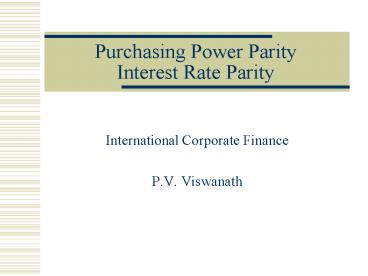Purchasing Power Parity Interest Rate Parity - PowerPoint PPT Presentation
Title:
Purchasing Power Parity Interest Rate Parity
Description:
Purchasing Power Parity Interest Rate Parity – PowerPoint PPT presentation
Number of Views:264
Avg rating:3.0/5.0
Title: Purchasing Power Parity Interest Rate Parity
1
Purchasing Power ParityInterest Rate Parity
- International Corporate Finance
- P.V. Viswanath
2
Learning Objectives
- Law of One Price
- How arbitrage links good prices and asset returns
- Relations between spot and forward exchange
rates, inflation rates and interest rates - Difference between real and nominal exchange rates
3
Arbitrage
- Law of One Price in competitive markets with
many buyers and sellers with low-cost access to
information, exchange-adjusted prices of
identical tradable goods and financial assets
must be within transaction costs worldwide. - Risk-adjusted expected returns on financial
assets in different markets should be equal.
4
Law of One Price
- In the absence of frictions, the same good will
sell for the same price in two different
locations. - Either because of two-way arbitrage or
- Because buyers will simply go to the lower cost
seller - If goods are sold in different locations using
different currencies, then - The law of one price says after conversion into
a common currency, a given good will sell for the
same price in each country. - If 10.8 (11.25), and a bushel of wheat
sells for 15, it must sell for (15)(0.8) or 12
in the UK.
5
Static PPP
- If e is the / exchange rate (i.e. the number of
needed to buy 1, then - P e.P
- Hence, e P/P
- The static PPP is difficult to test because
different baskets of goods are consumed in
different countries indexes reflect different
consumptions.
6
Dynamic PPP
- The dynamic PPP simply states that the absolute
PPP relationship will hold in terms of changes
if ? refers to the inflation rate, then - (et1-et)/et (?- ?)/(1?)
- Thus, if a unit of consumption costs 15 in the
US and 12 in the UK, we have seen static PPP
holds. - If inflation is 10 in the UK and 20 in the US,
then, prices will be 18 in the US and 13.2 in
the UK. Then, static PPP will require that e
18/13.2 or 1.36. - The percentage change in e is (1.36-1.125)/1.125
9.09 - The RHS is also (0.2-0.1)/1.1 9.09
7
Static vs. Dynamic PPP
- In the above example, both static and dynamic PPP
holds. - But, suppose the original exchange rate were not
1.25, but 1.3/, due to some friction. - Then dynamic PPP would assert that the exchange
rate would increase by 9.09 or rise to
1.3(1.0909) or 1.4182/. - If price changes are not too large, then approx.,
- (et1-et)/et (?- ?)
- If we take the expectation of both sides, we find
- E(et1-et)/et E(?- ?)
- The expected change in interest rates will be
equal to the expected differential in inflation
rates.
8
Causes for deviation from PPP
- PPP is reinforced by two-way arbitrage
- If transportation of goods is costly, static PPP
is violated. - Import tariffs and quotas can cause static PPP
violations. - Many items cannot be traded such as on-site
services (haircuts), perishable goods, etc.
Hence PPP measured with standard price indexes
can be violated. - Movement of buyers can compensate for movement of
goods, sometimes. For example, vacations. - Movement of producers can also compensate.
Producers will move to places where the goods
price is high. - In the long run, PPP should hold even if there
are non-traded goods.
9
Covered Interest Rate Parity
- Investing 1 for 1 year will generate (1r),
where r is the rate quoted on dollar-denominated
investments. - Investing 1 for 1 year in pound-denominated
investments will generate (1/e0)(1r). If e1
is the future exchange rate, this will equal
(e1/e0)(1r). However, the value of this
expression depends on e1 and is unknown at t0. - If f1 is the forward exchange rate for delivery
at t1, then the pound value, which is known in
advance can be converted to (f1/e0)(1r).
Hence, we find - 1r (f1/e0)(1r) or equivalently,
(1r)/(1r) f1/e0 - Or approx. the forward premium, (f1- e0)/e0 r
- r
10
Uncovered Interest Rate Parity
- The Unbiased Expectations Hypothesis says that
the forward rate is equal to the expected future
spot rate. - If the forward rate is greater than the expected
future spot rate, then speculators will sell the
foreign currency forward. If the forward rate is
lower than the expected future spot rate, then
they will buy forward contracts on the foreign
currency. - Putting this together with the covered interest
rate parity condition, we derive the uncovered
interest rate parity condition (also known as the
International Fisher Equation) - E(e1- e0)/e0 r - r
11
Deviations from Covered Interest Parity
- Although covered interest parity generally holds,
there could be deviations because of - Transactions costs
- Politifal Risks
- Potential tax advantages to foreign exchantge
gains versus interest earnings - Liquidity differences between foreign and
domestic securities.
12
Fisher Open condition
- Take the uncovered interest rate parity
condition, E(e1- e0)/e0 r - r together with - the expectations form of the PPP E(e1- e0)/e0
E(?- ?). This gives us - r - r E(?- ?)
- This is known as the Fisher Open Condition
13
The Fisher Effect
- Irving Fisher decomposed the nominal interest
rate into the real interest and the expected
inflation rate. - If capital is mobile across countries, then real
interest rates should equalize. - This implies that differences in nominal interest
rates across countries should reflect differences
in expected inflation. - Combining this with the expectations form of the
PPP, we have the International Fisher Effect - the interest rate differential between two
countries is an unbiased predictor of the future
change in the spot rate of exchange.































